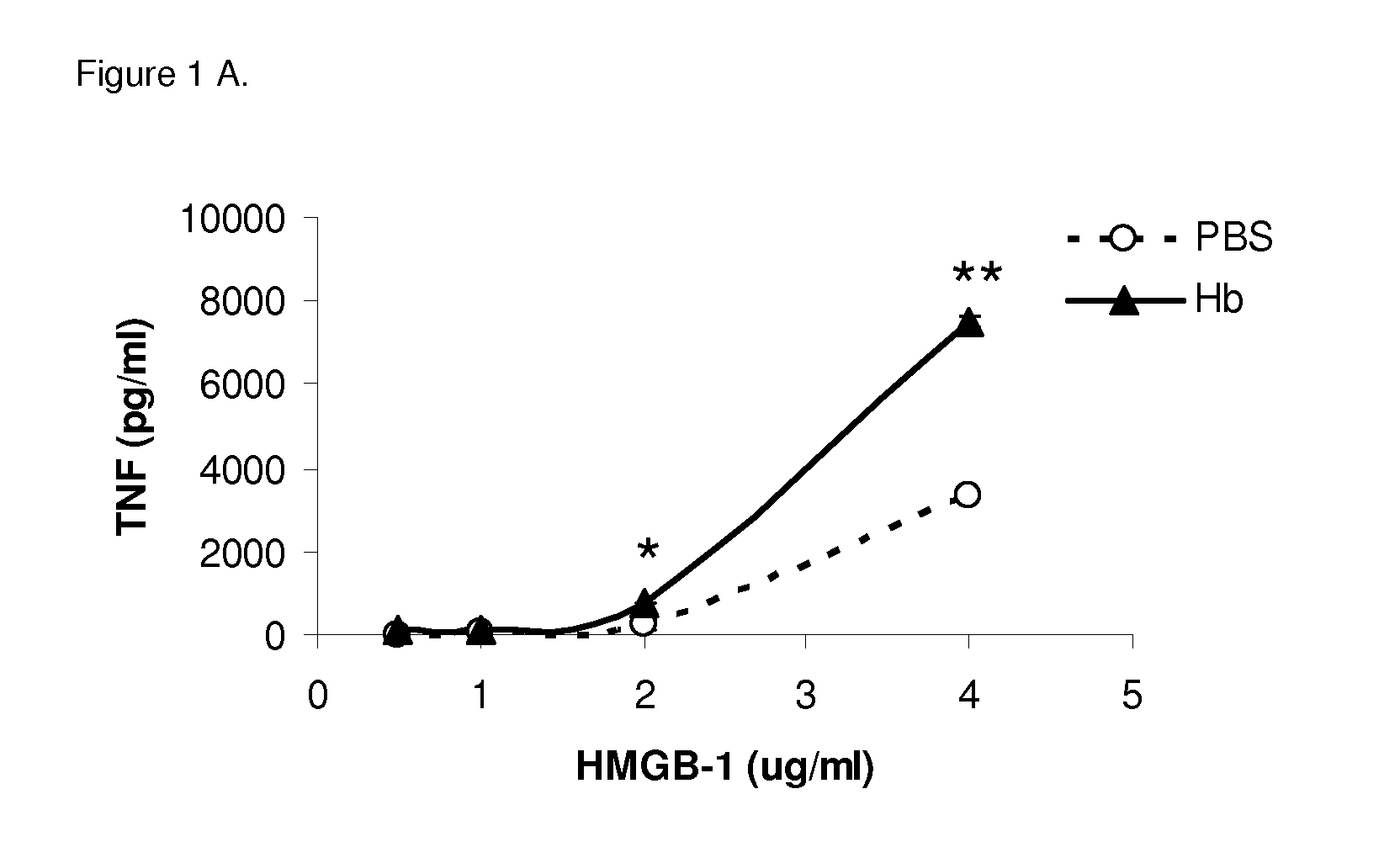Use of hemopexin to sequester hemoglobin
a technology of hemoglobin and hemoglobin, which is applied in the direction of extracellular fluid disorder, drug composition, peptide/protein ingredients, etc., can solve the problems of hemorrhagic stroke, damage to healthy tissue, and exacerbate trauma or negative effects, so as to reduce inflammation and reduce the risk of developing inflammation
- Summary
- Abstract
- Description
- Claims
- Application Information
AI Technical Summary
Benefits of technology
Problems solved by technology
Method used
Image
Examples
example 1
Materials and Methods
[0064]The experiments described herein may be carried out using the following materials and methods.
[0065]Materials
[0066]The following TLR agonists were purchased: smooth LPS from E. coli O55:B5 (List Biologicals), Pam3Cys (EMC Microcollections). All TLR agonists were dissolved in pyrogen-free H2O and saved as aliquots at −80° C. C57BL / 6, TLR2 knockout, C3H / HeN, and C3H / HeJ mice were obtained from Charles River Labs. Recombinant HMGB1 was expressed in E. coli and purified to homogeneity as previously described (Wang et al., Science, 285: 248-251, 1999; Li et al., J. Immunol. Meth., 289: 211-223, 2004). Briefly, HMGB-1 was cloned by DNA amplification from Rat Brain Quick-Clone cDNA (Clontech, Palo Alto, Calif.). The PCR product was subcloned into the pCAL-n vector with a calmodulin binding protein (CBP) tag (Stratagene, La Jolla, Calif.).
[0067]Limulus Amoebocyte Lysate (LAL) Assay
[0068]The LAL assay was performed as previously described (Novitsky et al., J. Clin....
example 2
Hemoglobin Strongly Synergizes with HMGB1 to Induce TNF and IL-6 from Macrophages
[0079]Different concentrations of HMGB1 were incubated with a predetermined optimized concentration of mouse Hb in cell culture with BMDMs. Bone marrow-derived macrophages (BMDMs) from C57BL / 6 mice were cultured with HMGB1 at different concentrations with mouse Hb (30 82 g / ml). Pro-inflammatory cytokines TNF and IL-6 levels in the supernatant were measured by ELISA. HMGB1 at concentrations above 1 μg / ml induced low levels of TNF (FIG. 1). Hemoglobin alone could not induce detectable TNF at concentrations up to 1,000 μg / ml (Lin et al., J. Infect. Dis. 2010, 202: 624-632), but significantly enhanced the production of TNF from BMDMs by HMGB1 at different concentrations (FIG. 1A), and this effect was dose dependent (FIG. 1C). Similar results were found with IL-6 induced in the culture (FIGS. 1B and 1D). Human Hb (hHb) also synergized with HMGB1 to induce high levels of TNF and IL-6.
example 3
Synergistic Induction of Pro-Inflammatory Cytokines by HMGB1 and Hemoglobin are Partially Dependent of TLR2 and TLR4
[0080]Because HMGB1 binds to TLR4 and probably TLR2 to activate macrophages, we addressed the question of whether the synergy of Hb with HMGB1 works through TLR4 or TLR2 signaling pathways. For these experiments, the synergistic induction of cytokines induced in BMDMs from TLR2 knockout (TLR2KO) mice was compared with induction of cytokines from control wild-type C57 / BL6 mice (FIG. 2A), while C3H / HeJ mice, which are deficient in TLR4, was compared with induction of cytokines from control BMDMs from C3H / HeN mice stimulated with HMGB1 in the absence or presence of hemoglobin (FIG. 2B). BMDMs from C57BL / 6 (control) and TLR2 knockout (TLR2KO) mice, or BMDMs from HeN (control) and HeJ mice (deficient for TLR4), were cultured with Pam3Cys (P3C), LPS, or HMGB1 (4 μg / ml) with or without Hb (30 μg / ml). Concentrations of TNF in the supernatant were determined by ELISA. TLR2 agon...
PUM
| Property | Measurement | Unit |
|---|---|---|
| weight | aaaaa | aaaaa |
| pH | aaaaa | aaaaa |
| pH | aaaaa | aaaaa |
Abstract
Description
Claims
Application Information
 Login to View More
Login to View More - R&D
- Intellectual Property
- Life Sciences
- Materials
- Tech Scout
- Unparalleled Data Quality
- Higher Quality Content
- 60% Fewer Hallucinations
Browse by: Latest US Patents, China's latest patents, Technical Efficacy Thesaurus, Application Domain, Technology Topic, Popular Technical Reports.
© 2025 PatSnap. All rights reserved.Legal|Privacy policy|Modern Slavery Act Transparency Statement|Sitemap|About US| Contact US: help@patsnap.com



